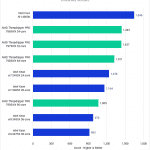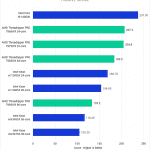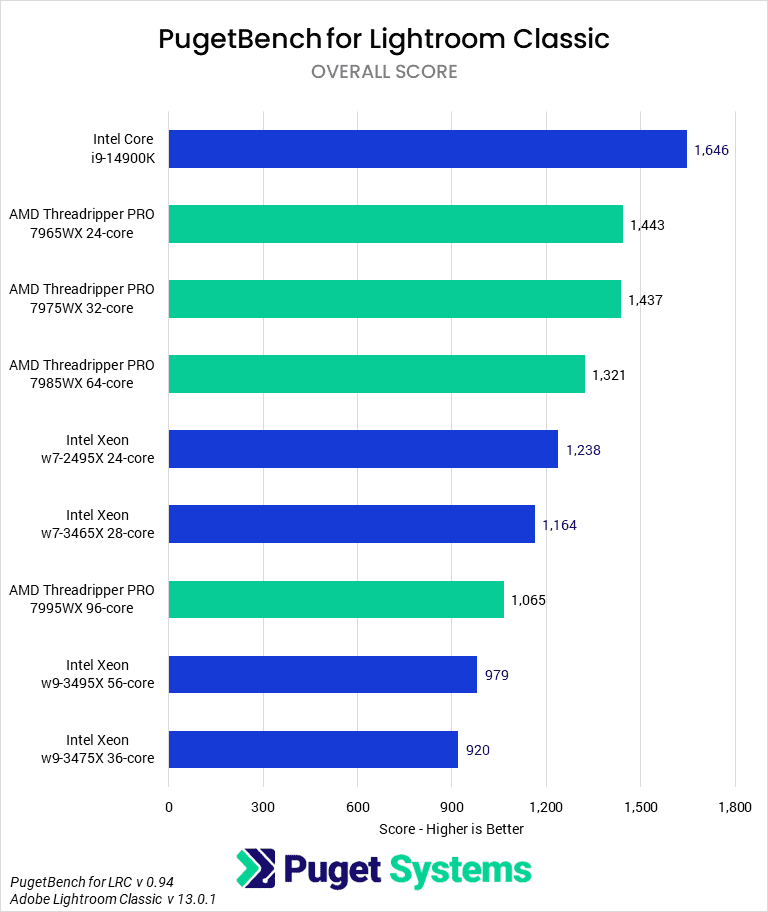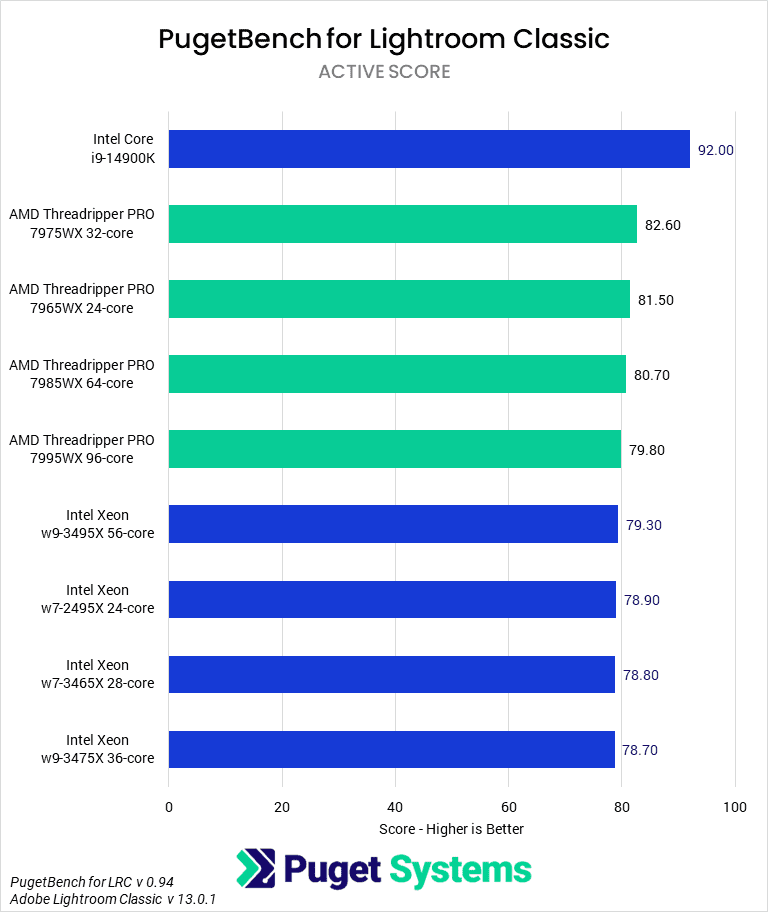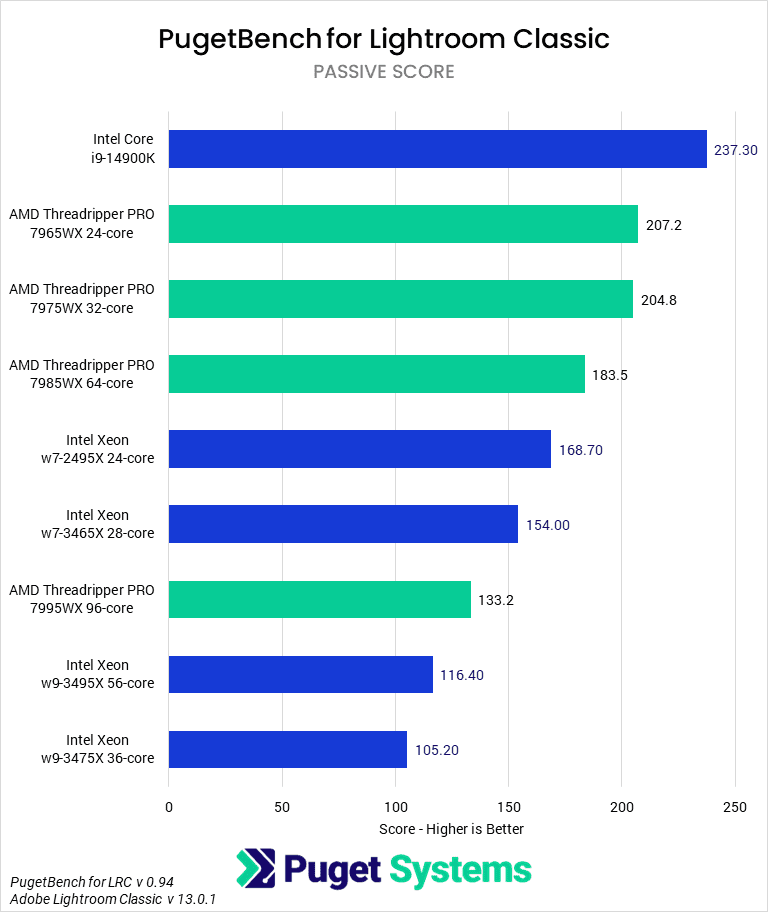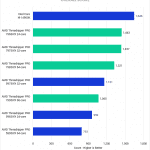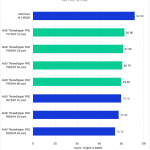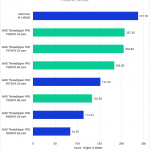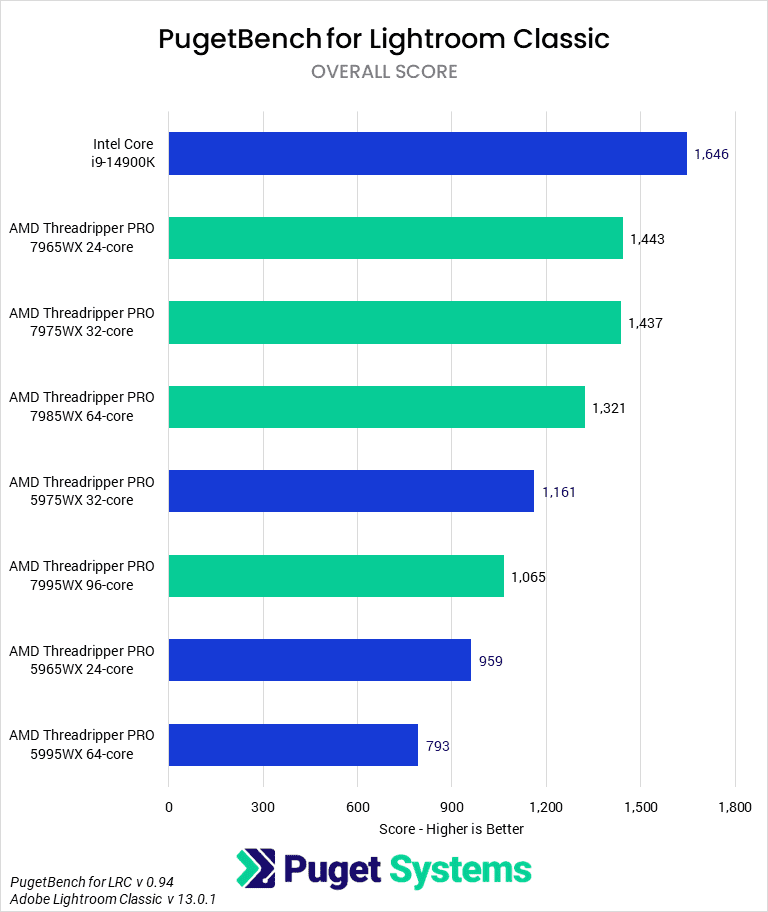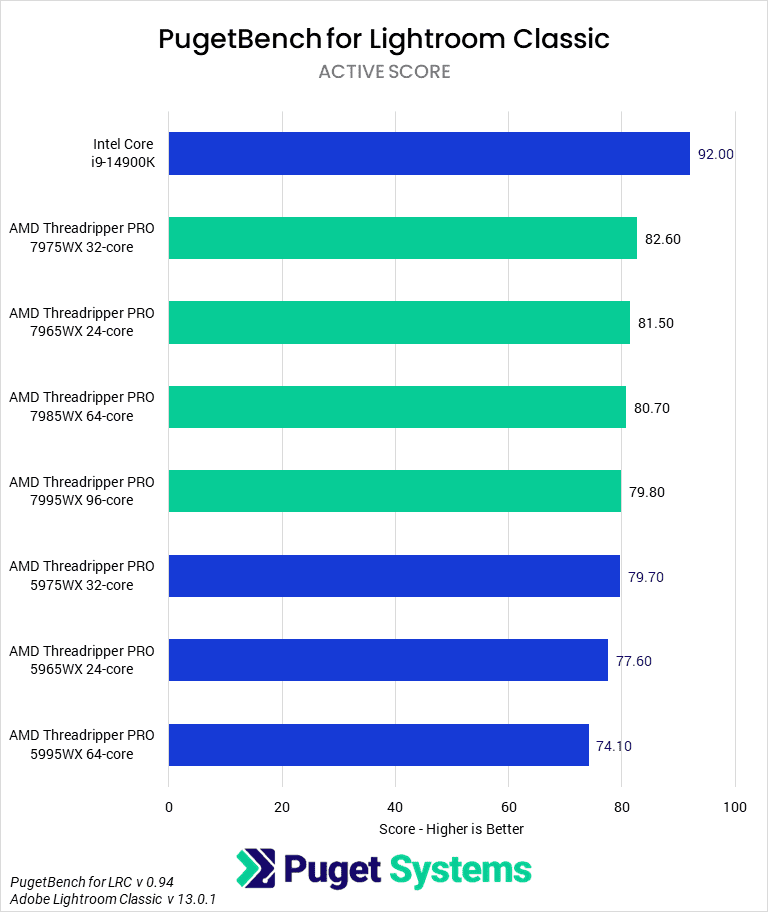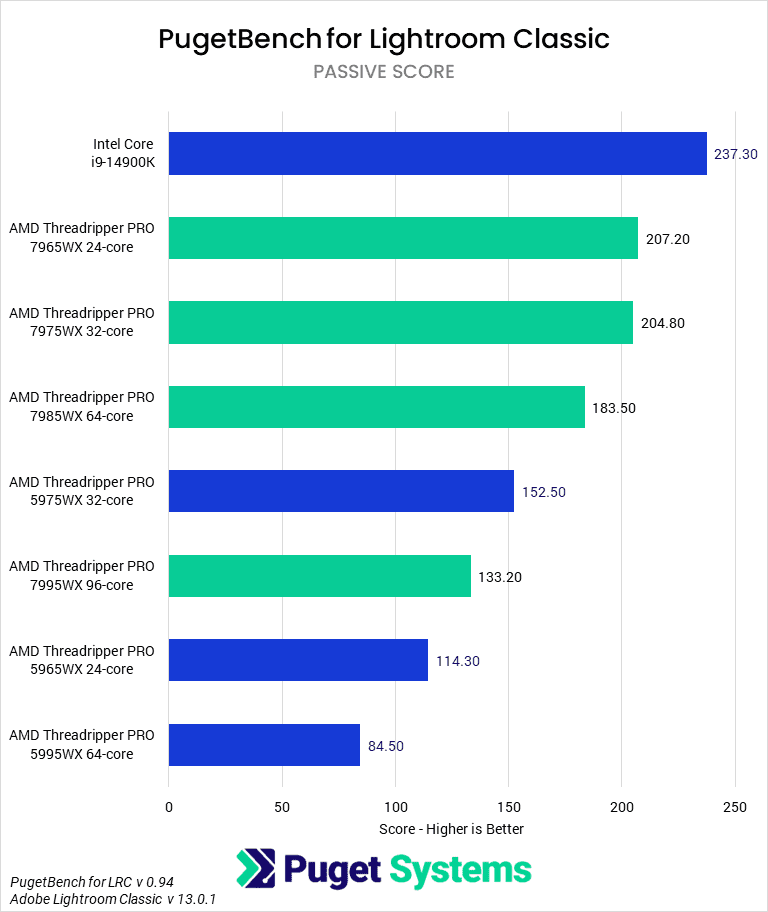Table of Contents
TL;DR: AMD Threadripper PRO 7000 WX-Series Performance in Lightroom Classic
While the new AMD Threadripper PRO 7000 WX-Series processors showed some very impressive gen-over-gen performance gains, it is worth pointing out that if performance in Lightroom Classic is your primary concern, an Intel Core or AMD Ryzen CPU (or the normal Threadripper 7000 series) is going to give you more performance at a significantly lower price. Even for tasks that can take advantage of multiple cores, that class of CPU is simply a better fit for how Lightroom Classic utilizes hardware.In addition, Lightroom Classic tends to show significant performance degradation above the 32-core mark, which makes the new $10,000 96-core Threadripper PRO 7995WX a particularly poor pairing. Even the Threadripper PRO 7965WX 24-core is 35-55% faster, at less than a third of the cost.
Still, in workflows that could benefit from the raw horsepower that Threadripper and Xeon CPUs can provide, if you only consider the models that make the most sense for Lightroom Classic, we are looking at about a 17-60% performance lead for AMD Threadripper PRO 7000 WX-Series over Intel Xeon W-2400/3400 processors.
Introduction
In the past, portions of Adobe Lightroom Classic (primarily importing, exporting, and generating previews)benefited from workstation-class processors like AMD Threadripper PRO or Intel Xeon. However, with the ever-increasing core count on consumer-grade processors like AMD Ryzen and Intel Core, we are now at the point where even a mid-range CPU has more cores than Lightroom Classic can effectively utilize.
Because of this, the new AMD Threadripper PRO 7000 WX-Series (with up to 96 cores!) is, in almost every case, complete overkill for Lightroom Classic. While the per-core performance on modern Threadripper processors has been significantly improved compared to previous generations, a consumer-class CPU like AMD Ryzen or Intel Core will typically give you better performance at a fraction of the cost.
However, we have been surprised in the past with performance being higher (or lower) than we expected, which is why we will still put the Threadripper PRO 7000 WX-Series through our full Lightroom Classic testing. With their “7000” series of processors, it is important to be aware that AMD is splitting their high core-count CPUs into two separate product families: the High-End Desktop (HEDT) AMD Ryzen Threadripper 7000 Series, and the even higher tier AMD Ryzen Threadripper PRO 7000 WX-Series processors. Both are based on AMD’s Zen 4 architecture, which means they now support new technologies like PCI-e Gen 5.0 and DDR5 memory, but the “PRO” line includes twice the number of memory lanes (8 channel vs 4 channel) and more than twice the number of PCIe lanes (128 vs 48). In addition, the higher line also includes a 96-core processor for those workloads that benefit from having a massive number of CPU cores.
None of these features should impact Lightroom Classic, so we don’t expect to see anything significantly different with the Threadripper PRO 7000WX processors than we did in our recent review of the Threadripper 7000 line. With that said, we have a dedicated AMD Threadripper 7000 vs Threadripper PRO 7000WX for Content Creation article if you want to see exactly where (and by how much) it may make sense to invest in the PRO line. But in this article, we want to focus on the performance of the Threadripper PRO 7000 WX-Series compared to the previous generation Threadripper PRO 5000WX and the Intel Xeon W-2400/3400 line. In addition to Threadripper PRO and Xeon, we will also include the Intel Core 14900K to provide some context for how AMD Threadripper PRO compares to a more typical CPU choice for this type of workload.
Because there are so many CPUs to examine, we will break our analysis down into Intel vs AMD (AMD Threadripper PRO 7000WX vs Intel Xeon W-3400) and performance versus the previous generation (AMD Threadripper PRO 7000WX vs AMD Threadripper PRO 5000WX)
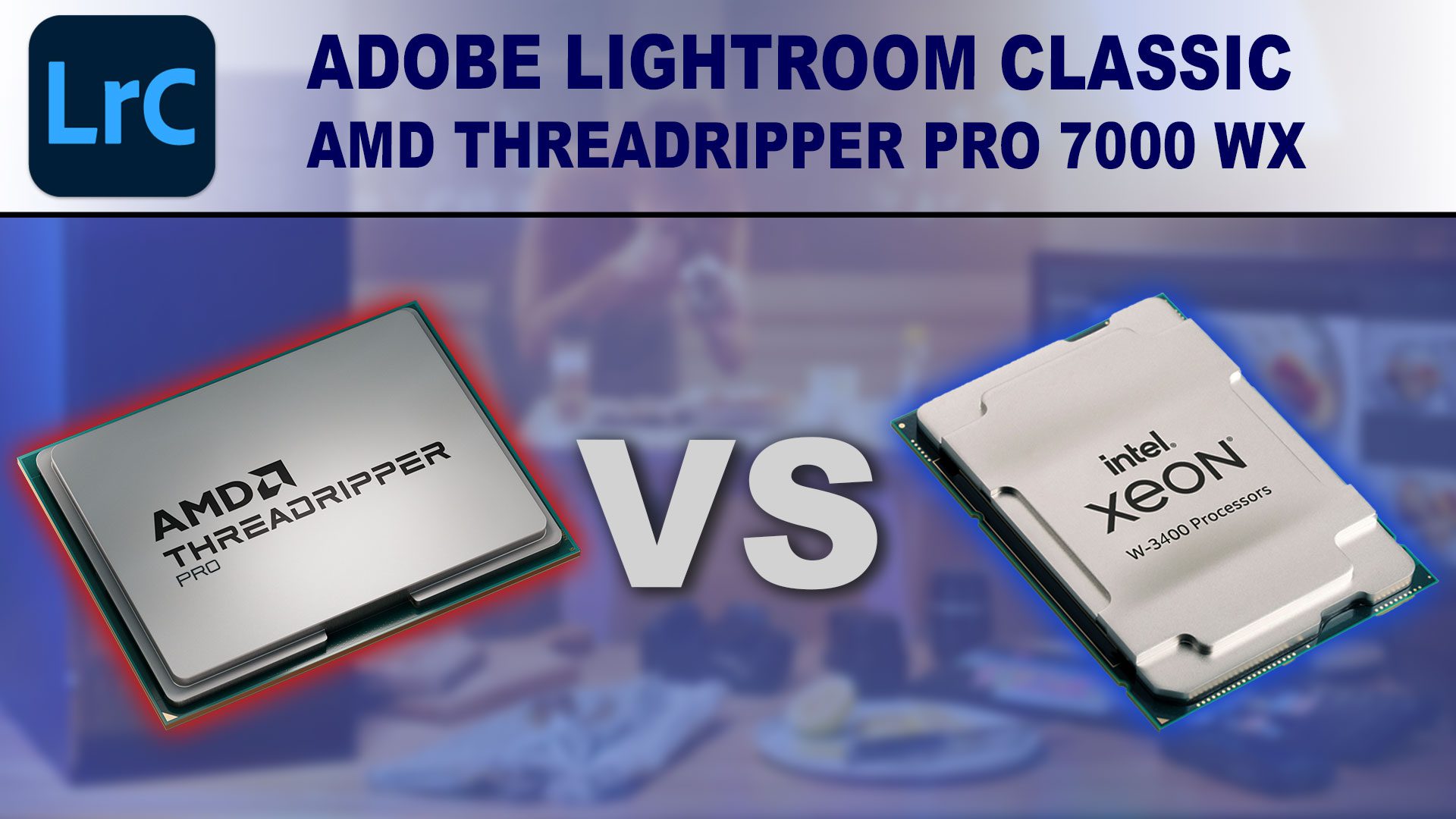
To learn more about how the new AMD Ryzen Threadripper PRO 7000 WX-Series processors perform in other workflows, we have compiled an overview in our AMD Ryzen Threadripper PRO 7000WX Content Creation Review article. That post also includes more detailed information on the CPU specifications and test results for various applications: Photoshop, Lightroom Classic, DaVinci Resolve, After Effects, Unreal Engine, Cinema 4D, Blender, and V-Ray.
In addition, although all the new AMD CPUs have a TDP of 350 W, TDP is rarely the whole story. To see how much power these chips use to complete tasks, check out our Power Analysis: AMD Ryzen Threadripper 7000 article. That is specifically looking at the non-Pro models, but both Threadripper lines have the same power draw and can be considered interchangeable regarding CPU power draw and cooling.
Raw Benchmark Data
We design our benchmarks to cover many workflows and tasks to provide a balanced look at the application and its hardware interactions. However, many users have more specialized workflows. Recognizing this, we like to provide individual results for benchmarks as well. If a specific area comprises most of your work, examining those results will give a more accurate understanding of the performance disparities between components.
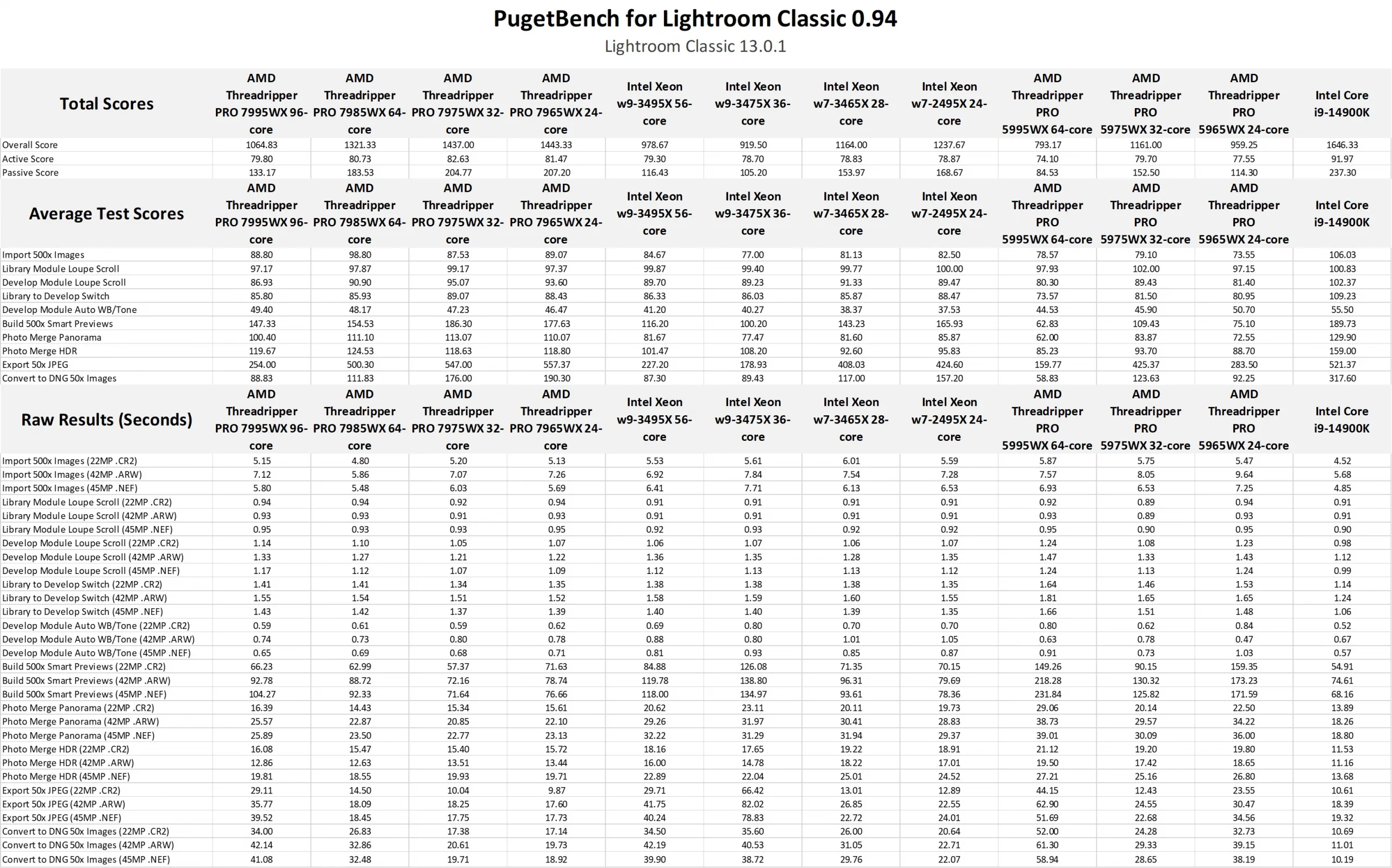
AMD Threadripper PRO 7000WX vs Intel Xeon W-3400 for Adobe Lightroom Classic
Unlike applications like Photoshop, which are fairly linear in how they use hardware, Lightroom Classic behaves very differently depending on the type of task you are looking at. Our benchmark breaks down the tests into two groups: active and passive. Active tests (chart #2) look at things like switching modules, scrolling through images, and other tasks that individually take a short amount of time but that you do hundreds or thousands of times a day. These tasks are typically lightly threaded, and performance is based mainly on the per-core performance of your CPU. Because of this, you tend not to see much difference between CPUs of the same family, and consumer CPU lines like Intel Core or AMD Ryzen tend to be a bit faster than processor families like Threadripper PRO and Xeon.
On the other hand, passive tasks (chart #3) like importing, exporting, and generating previews are moderately threaded and – up to a certain point – can utilize CPUs with more cores. However, in most cases, even what is available from an Intel Core or AMD Ryzen CPU is enough to “saturate” Lightroom Classic, so once again, Threadripper PRO and Xeon tend to underperform compared to more affordable CPU families. In addition, Lightroom Classic shows performance degradation when you have more than 32 cores (or, more accurately, 64 threads) due to how Windows divides a processor into multiple logical processor groups above that point. Unless an application is programmed to consider these groups, it can result in a heavy performance penalty for very high-core count CPUs (as seen by the 64- and 96-core results being worse than the 24/32 core models)
This means that CPUs like Intel Core and AMD Ryzen are simply a better fit for Lightroom Classic, and can give you more performance at a significantly lower cost. Still, some use cases exist where a user may opt to take a performance hit in Lightroom Classic to get better performance in other aspects of their workflow. For example, this is a common situation for those who do both photography and photogrammetry.
Interestingly, comparing AMD Threadripper PRO and Intel Xeon is a bit tough to do because, in both cases, the lowest core count model (Threadripper PRO 7965WX 24-core and Intel Xeon w7-2495X 24-core) is the fastest performing model from each family. AMD takes the lead between these two models with 17% higher overall performance, or 23% for passive tasks, although the 7965WX is a bit more expensive.
Going above that level is a bit awkward since if you want to prioritize performance in Lightroom Classic, there would be no reason to consider a higher core count model. But, at the same time, if Lightroom Classic was all you cared about, you would use an Intel Core i9 14900K and call it a day. Since performance in other applications (with Lightroom Classic being a secondary application) is the main reason you would be interested in AMD Threadripper PRO or Intel Xeon W at all, we will continue with the AMD vs Intel comparisons – just keep in mind that as you go up in core count, you tend to take more and more of a performance hit.
With that explained, the AMD Threadripper PRO 7975WX 32-core is priced slightly above the Intel Xeon w9-3475X 36-core, but is 60% faster overall, or nearly 2x faster for passive tasks. This isn’t quite a fair comparison for Intel, however, since the 3475X is just above the 32-core threshold for Windows treating the CPU as two separate logical processor groups, which can at times be even more problematic than having a CPU with an even higher core count where the logical processor groups are more evenly distributed. In fact, it is such a problem in Lightroom Classic that the Xeon w9-3475X 36-core is the lowest-performing CPU we tested, even behind the 96-core Threadripper PRO or 56-core Intel Xeon.
Moving up a step, the Threadripper PRO 7985WX 64-core is about 10% slower than the 24/32 core models and is priced well above any Intel Xeon W-3400 processor. It is closest to the Xeon w9-3495X 56-core, but at a $1,450 premium ($7,350 vs $5,900). Still, it compares well to Intel, coming in at 35% and 58% faster for overall performance and passive tasks, respectively.
At the very top, the Threadripper PRO 7995WX 96-core is in a class of its own, with no Intel Xeon W processor coming close in price. Again, the closest is the Intel Xeon w9-3495X 56-core, but the 7995WX is more than $4,000 more expensive ($10,000 vs $5,900). Performance in Lightroom Classic is again better than Intel, but 35-54% behind the 24- and 32-core Threadripper PRO models. Still, if you wanted to do a direct comparison to Intel, the 7995WX is about 10-15% faster than the w9-3495X.
AMD Threadripper PRO 7000WX vs AMD Threadripper PRO 5000WX for Adobe Lightroom Classic
When comparing the new AMD Threadripper PRO 7000WX CPUs to the previous generation, you need to be aware that AMD introduced a price increase in this generation. The exact amount varies, but ranges from 10% with the 24-core models, to ~15% with the 32-core, and ~20% with the 64-core. In addition, the 96-core is well above anything from the previous generation. Still, a core-to-core comparison is the closest we can do; just keep in mind that the gen-to-gen performance gain needs to be enough to overcome the price increases with this generation.
Starting at the lower end, the new Threadripper PRO 7965WX 24-core is $250 more expensive than the Threadripper PRO 5965WX 24-core, but performs about 50% higher, which more than offsets the price increase. Almost all of the gains come from the improved performance for passive tasks (chart #3) like importing and exporting, where it ended up being a massive 80% faster, or nearly twice as fast!
Moving up one level to the Threadripper PRO 7975WX 32-core, the closest price comparison is the Threadripper PRO 5975WX 32-core, where the new model is $600 more expensive. With that comparison, the new 7975WX is about 24% faster overall, with most of that coming from passive tasks to the tune of a 35% performance increase.
As we explained in the previous section, the 64-core Threadripper PRO 7985WX and 96-core Threadripper PRO 7995WX are not likely CPUs you would choose for Lightroom Classic, since this application tends to have problems with CPUs that have more than 32 cores. However, it is worth pointing out that the new 7985WX doesn’t seem to be impacted nearly as much as the previous generation. The 32-core 7975WX will still be faster, but only to the tune of ~9%. For reference, the previous generation Threadripper PRO 5975WX 32-core was around 50-80% faster than the 64-core 5995WX. Since it appears AMD was able to mitigate Lightroom Classic’s limitations in some ways, that makes the new 7985WX about 65% faster than the 5995WX overall, or more than 2x faster for passive tasks.
The Threadripper PRO 7995WX 96-core, however, takes a massive performance hit in Lightroom Classic. It is still faster than many of the previous generation Threadripper PRO 5000 WX-Series, but the 32-core 5975WX is faster in all cases, and at about a third of the cost.
How Well Do the AMD Threadripper PRO 7000WX CPUs Perform in Lightroom Classic?
While the new AMD Threadripper PRO 7000 WX-Series processors showed some very impressive gen-over-gen performance gains, it is worth pointing out that if performance in Lightroom Classic is your primary concern, an Intel Core or AMD Ryzen CPU is going to give you more performance at a significantly lower price. Even for tasks that can take advantage of multiple cores, that class of CPU is simply a better fit for how Lightroom Classic utilizes hardware.
In addition, Lightroom Classic tends to show significant performance degradation above the 32-core mark, which makes the new $10,000 96-core Threadripper PRO 7995WX a particularly poor pairing. Even the Threadripper PRO 7965WX 24-core is 35-55% faster, at less than a third of the cost.
Still, there are some workflows where you may be using Lightroom Classic alongside other applications that can benefit from the raw horsepower that Threadripper and Xeon CPUs can provide. For those workflows, the new Threadripper PRO 7000WX processors are particularly good for passive tasks like importing and exporting photos, where they are anywhere from 24% to 2x faster than the previous generation. Active tasks like scrolling through images and switching modules, however, are about on par with the previous generation.
Compared to the Intel Xeon W processors, passive tasks are again where most of the performance advantage is found, with significantly more performance compared to similarly priced Intel Xeon W processors. The exact amount is challenging to quantify since it depends on whether or not you include particularly bad results from CPUs like the Intel Xeon w9-3475X 36-core or the Threadripper PRO 7995WX 96-core, but for the models that make the most sense for Lightroom Classic, we are looking at about a 17-60% performance lead for AMD Threadripper PRO 7000 WX-Series over Intel Xeon W-2400/3400 processors.
For most users, however, Threadripper PRO is not the right product for Lightroom Classic. Even if you need more RAM or PCIe lanes than you could get with a more affordable (and faster for Lightroom Classic) CPU like an Intel Core i9-14900K, the normal AMD Threadripper 7000 processors are just as fast as the PRO models (as we show in our AMD Threadripper 7000 vs Threadripper PRO 7000WX for Content Creation article). But, if your overall workflows benefits from the 8-channel memory or 128 PCIe lanes that Threadripper PRO offers, the new Threadripper 7975WX, in particular, is within 15% of the performance of the Intel Core i9 14900K. That is a small enough difference that it would be hard to notice unless you are looking for it, which will help with workflows that combine Lightroom Classic with heavier workloads like photogrammetry.
Every application uniquely utilizes hardware, so our results here don’t necessarily translate to any other application. Our focus in this article centers specifically on Threadripper PRO 7000 WX-Series performance in Adobe Lightroom Classic. However, we recommend checking out our AMD Ryzen Threadripper PRO 7000 WX-Series Content Creation Review article, which includes a broad overview of results for several different applications. If you use other software packages, it also has links to our in-depth testing articles for content creation: Photoshop, Premiere Pro, DaVinci Resolve, After Effects, Unreal Engine, Cinema 4D, Blender, and V-Ray.
Finding the perfect workstation doesn’t have to be complicated. Explore our solutions page for a curated selection of recommended systems for a multitude of applications and workflows, or visit our custom configuration page if you already know the ideal hardware for your needs. If you need assistance with tailoring a system to a unique workflow or have any other questions, we encourage you to reach out to our dedicated technology consultants.


